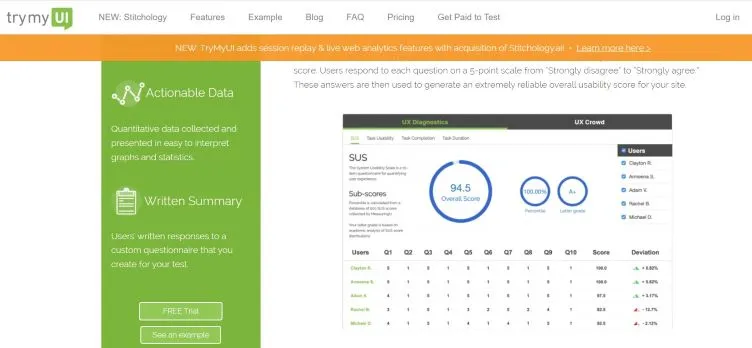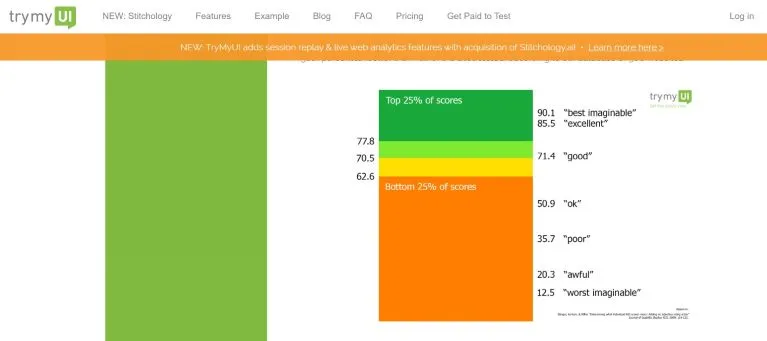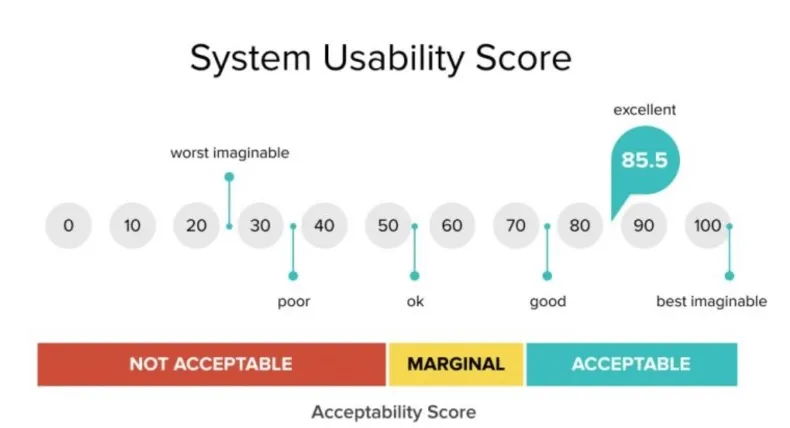A digital product (application, service, software) that doesn't have a sufficient level of usability doesn't have the slightest chance in the market race.
Usability and usability tests are mandatory if you want to gain an advantage in the market. Only products that ensure an appropriate level of usability and user experience have a chance to compete successfully and build lasting relationships with customers and users.
During digital product creation, the word "usability" is notoriously used. Both in the context of design, research, and optimization as well as development.
Usability is a design, research, and (user testing, usability testing) methodological problem.
Usability is a challenge. Ultimately, the problem with usability always comes down to the questions of for whom a digital product is supposed to be useful, when it becomes useful, and to what extent it's useful.
And in what context of use is it useful? And, which is no less important when it becomes useful/not useful?
The resolution of these issues can't be a matter of subjective feelings, but it should be based on unbiased, objective, measurable metrics, ratings, and reference points that allow you to diagnose usability.
Even if the measurement, the comparison isn't perfect.
One of the tools which are used to solve this problem is the System Usability Scale (SUS).
What is the System Usability Scale? Why is it worth using it?
What are the weak and strong sides of the System Usability Scale? What is measured by tools like SUS?
Why the measurement of the perceived usability with the System Usability Scale (SUS) has a real and practical effect?
After this initial introduction, there is nothing left to do but invite you to read on!
Usability — what is it?
Experts and researchers from Nielsen Norman Group define usability in the article "Usability 101: Introduction to Usability" as an attribute of quality, thanks to which it's possible to assess how easy/difficult it is to use a user interface.

They also propose associating the word "usability" with methods of improving that difficulty in the process of designing web or mobile applications and studying them through user experience research.
The definition proposed by Interaction Design Foundation (IDF) authors in the article "What is Usability?" is an addition to the above.
According to it, usability is a measure of how well a specific user within a particular context can use a product.
The definition proposed by the IDF also emphasizes the efficiency, effectiveness, and satisfaction that should accompany the user who, with a given system, wants to achieve their goal.
The role of usability testing is also highlighted. However, as IDF authors rightly add, this research should be performed at every stage of digital product development.
They also add another valuable point about equating usability with user experience. According to them, people too often confuse usability with user experience and ease of use.
Usability is a way in which the user can effectively interact with a product.
Furthermore, usability is a complex concept, defined through four main elements:
- Learnability
- Efficiency
- Memorability
- Errors
- Satisfaction.
When looking at connections between usability and user experience, it's essential to emphasize that they're not synonymous.
Usability and user experience are two different terms. Usability is a narrower term and is contained in the concept of user experience design.
It's also worth remembering that user experience consists of four elements, which we wrote about in the article "Design Problem: Usability vs. Desirability."

Namely:
- Usability
- Utility
- Desirability
- Brand Experience.
Now you know what usability is, and now we can move on to the heart of this article: the definition and characteristics of the System Usability Scale.
System Usability Scale (SUS) — what is it?
What is the SUS questionnaire? What does it consist of?
In the article published on NN Group's blog, "Beyond the NPS: Measuring Perceived Usability with the SUS, NASA-TLX, and the Single Ease Question After Tasks and Usability Tests," SUS is defined as a questionnaire consisting of ten questions.

SUS is one of the most popular questionnaires used in user experience research, although it's not an entirely new tool. The scale was developed in the '80s.
The System Usability Scale makes it possible to quickly and simply assess a given digital product by performing a usability test. It's a tool for conducting usability evaluation. SUS provides insight into how people perceive and evaluate the ease of use of a particular website or mobile application. For example, it can provide answers to the questions such as "Is the system functioning smoothly?" "Are all functions well-integrated?."
The questionnaire contains ten questions about usability and the ability to effectively learn how the system works.
The System Usability Scale is most often used after tasks, thanks to which it's possible to see how a respondent, user evaluates and perceives the system.
The Likert scale
The System Usability Scale is based on the classic Likert scale. It was created in 1932 by Rensis Likert, an American sociologist and social psychologist. To this day, the scale is a handy tool for measuring reactions.
The Likert scale includes five declarations arranged in a fixed order from complete disagreement to complete agreement.
The classic Likert scale looks as follows:
- Strongly disagree
- Disagree
- Neutral
- Agree
- Strongly agree.
Although the Likert scale may look like a qualitative tool at first, it makes it possible to measure the intensity of attitude in a quantitative way.
The Likert scale assumes the linearity of attitudes. The attitude can have different intensities; it builds up and oscillates around two extreme values and has a neutral option.
The Likert scale makes it possible to measure the frequency, quality, significance, and probability. Thus, it's a universal and flexible tool. The System Usability Scale consists of ten questions to which respondents respond with the five-point Likert scale.
The System Usability Scale template includes the following statements:
- I think that I would like to use this system frequently.
- I found the system unnecessarily complex.
- I thought the system was easy to use.
- I think that I would need the support of a technical person to be able to use this system.
- I found the various functions in this system were well integrated.
- I thought there was too much inconsistency in this system.
- I would imagine that most people would learn to use this system very quickly.
- I found the system very cumbersome to use.
- I felt very confident using the system.
- I needed to learn a lot of things before I could get going with this system.
Conducting a survey with the help of the SUS questionnaire is quick and cheap, and these are its main advantages.
When it comes to the methodology, the System Usability Scale is:
- Reliable
- Tested
- Commonly respected
- Often used
Among others, thanks to the vast array of uses.

Let's add that the System Usability Scale is not the only tool used in user experience research.
To some extent competitive, to some extent complementary tools to SUS are:
- SUMI — Software Usability Measurement Inventory
- SUPR-Q — Standardized User Experience Percentile Rank Questionnaire
- QUIS — Questionnaire for User Interface Satisfaction.
Each of them has advantages, but none of them is free of flaws or imperfections. None of them is a tool that can examine all problems with usability.
All of them can determine the level of usability only to a certain degree, from a certain perspective.
Who created the System Usability Scale (SUS)?
The System Usability Scale is not a new research tool. It was created in 1986 by John Brooke. Originally, it was used to measure the usability of electronic office systems.
The first websites appeared five years later, and they needed to wait for regular studies regarding design standards and development.
Nowadays, the System Usability Scale is mainly used for measuring the usability of mobile applications, web applications, or digital services. The results of this measurement are used to improve digital products.
Overall, the System Usability Scale created by John Brooke allows you to measure, among others, the efficiency of the digital product, that is, the speed with which it can be used.
It also can be used to determine the following:
- How easy it is to understand the product
- Learn how the product works
- Find out how intuitive it is.

The System Usability Scale makes it possible to learn whether the digital product is easy to use or satisfactory for users.
It's worth emphasizing this universal character of SUS. With its help, you can measure and study any digital product — applications, services, and software.
For the time being, it's hard to indicate a tool that is equally simple, quick, cheap, and simultaneously credible, reliable, and not questionable in terms of methodology.
It's also worth highlighting that SUS is a tool that meets the definition of usability described in the ISO 9241-11 standard, in which the most important matters are effectiveness, efficiency, and satisfaction.
In other words, John Brooke's questionnaire allows you to obtain answers to the following questions:
- Was the experience satisfactory?
- Can users effectively achieve their goals?
- How much effort and resources are spent to achieve these goals?
What does the System Usability Scale (SUS) measure?
It's a pretty important question from practical and methodological point of view.
Without going too deep into methodological, metatheoretical, or meta-methodological matters, we'll say that measuring the usability of a system is problematic because there is no such thing as the usability of a system per se.

There is no absolute usability that can be used as a reference point. Usability is always measured and defined in context.
A digital product is useful in specific conditions and contexts for specific users who use it for specific purposes.
This may result in a belief that such tools as the System Usability Scale are useless. Nothing could be further from the truth.
In science, studies, not excluding UX research, there are no perfect tools, methods, or research techniques that don't raise any objections. Each has a limited scope of use and can measure a phenomenon with a certain accuracy.
It's a fixed characteristic of scientific research that doesn't invalidate its meaning as such. However, using imperfect, credible data and results is always better than replacing them with speculations, intuition, or unconscious assumptions and prejudices.
The System Usability Scale, although not without faults, is a handy tool that provides results and data that can be used in the design and optimization processes.

The literature on this subject strongly emphasizes the credibility of results that the System Usability Scale ensures. Other research methods, such as A/B tests, can additionally verify these results.
Interpreting SUS scores
It's also worth highlighting and remembering that the result obtained with the System Usability Scale is quantitative, which means that it's possible to make an unbiased and objective comparison of reactions, for example, to two design variants.
Each result is expressed on a scale from 0 to 100 points; however, it's not a percentage result, which sometimes people forget. Sixty points do not mean 60% usability.
According to the interpretation proposed by Usability.gov (an American government website dedicated to, among other things, promoting best practices and user experience guidelines) in the article "System Usability Scale (SUS)," an average SUS score is above 68.
A SUS Score above 80.3 means near-perfect usability and a SUS score between 68-80.3 signifies very good usability.

A score of 68 points means good usability, a score between 51 and 68 indicates that the system has low usability, and 51 points mean that the usability is very, very bad.
How to calculate the SUS score?
We described how to interpret the individual SUS scores, but how should you calculate them?
There are three steps to this equation:
- For the odd statements (1, 3, 5, 7, 9), subtract 1
- For the even statements (2, 4, 6, 8, 10), subtract 5
- Lastly, you have to sum all the numbers and multiply them by 2.5
How would that look in practice?
Suppose that one of our test participants answered these ten questions like this:
- 2 (2 minus 1 equals 1)
- 4 (5 minus 4 equals 1)
- 1 (1 minus 1 equals 0)
- 5 (5 minus 5 equals 0)
- 2 (2 minus 1 equals 1)
- 3 (5 minus 3 equals 2)
- 4 (4 minus 1 equals 3)
- 2 (5 minus 2 equals 3)
- 4 (4 minus 1 equals 3)
- 4 (5 minus 4 equals 1)
Then we sum up all the results 1+1+0+0+1+2+3+3+3+1, which equals 15, multiply it by 2.5, and receive 37.5. This means that our usability is terrible and needs improvements as fast as possible.
What are the benefits of using SUS?
According to the article on HubSpot, "What's the System Usability Scale (SUS) & How Can You Use It?" there are three main benefits of using the System Usability Scale.
It gives you a summary of the usability your product/service provides
Since SUS uses numbers to express the usability of a given product, the score is easy to interpret and doesn't leave much space for misinterpretation.
It can be used with a small number of test participants, and it's easy to distribute
Because the System Usability Scale is a collection of ten questions, it can be distributed in various ways. You can compile them in the form of a survey and send them through e-mail or give them out in person.
It's reusable
No matter what you are trying to evaluate, SUS is a flexible and reliable tool that can help you. It can also assist you with making comparisons of the usability of different products.
What are the drawbacks of using SUS?
In another article, "System Usability Scale: What it is, Calculation + Usage," you can read about some drawbacks of using the System Usability Scale.
Every research method has some disadvantages. Nothing is perfect.
Therefore, you should be wary of the following:
- SUS is incapable of pointing out the precise weaknesses of a product/service
- It doesn't provide concrete steps that should be taken to fix issues with usability
- The answers provided by respondents are subjective.
What is the sample size for SUS?
As we mentioned, you can use SUS for small numbers of research participants. The sample size mainly depends on your needs and the target audience. SUS can be used for two respondents or fourteen.
You can use various sample size calculators to help you precisely determine the number of research respondents that you will need.
System Usability Scale — what is it? Summary
- Without usability, it's practically impossible to achieve market or business success.
- Usability is simultaneously a practical, theoretical, design, and research problem.
- Usability can be defined as an attribute of quality, thanks to which it's possible to assess how easy/difficult it is to use the user interface.
- Definitions of usability also emphasize the role of effectiveness, efficiency, and satisfaction, which a digital product is supposed to ensure.
- Usability is also a way in which the user can effectively interact with a product.
- The System Usability Scale is defined as a questionnaire that provides insight into how the ease of use of a digital product is perceived and assessed. In other words, it's used to conduct usability testing.
- The System Usability Scale is based on the classic Likert scale.
- The System Usability Scale consists of ten questions to which respondents respond with the five-point Likert scale.
- Conducting research with the help of the SUS questionnaire is quick and cheap, and these are its main advantages.
- SUS is a reliable, tested, and commonly respected tool.
- SUS is a tool that meets the definition of usability described in the ISO 9241-11 standard, in which the most important matters are effectiveness, efficiency, and satisfaction.
- A digital product is useful in specific conditions and contexts for specific users who use it for specific purposes.
- The System Usability Scale provides results and data that can be used in design, optimization, and development processes.
- Scores lower than 68 are considered below average.
- Scores lower than 50 are seen as "unacceptable."
- Scores from 51 to 70 are considered "marginal."
- Scores above 71 are seen as "acceptable."






